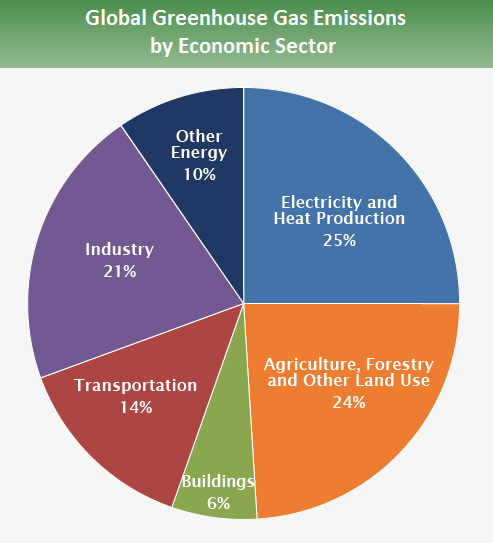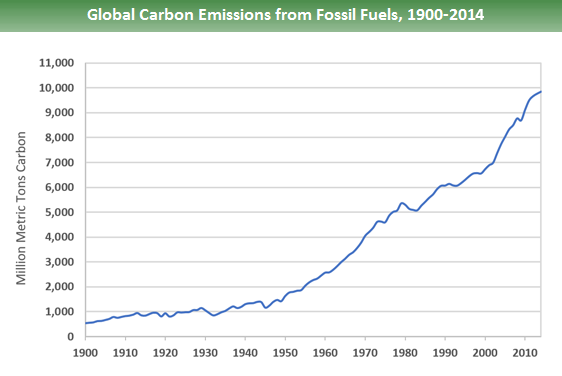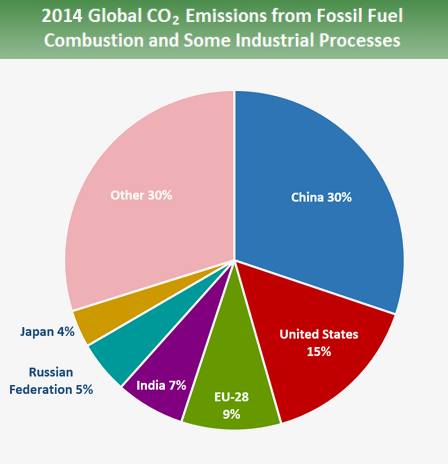What Percent Of Greenhouse Gases Come From Animal Agriculture
On This Folio:
- Global Emissions by Gas
- Global Emissions by Economic Sector
- Trends in Global Emissions
- Emissions past Country
Global Emissions by Gas
At the global calibration, the key greenhouse gases emitted by human activities are:
- Carbon dioxide (COii): Fossil fuel utilise is the primary source of CO2. CO2 tin can also be emitted from directly human-induced impacts on forestry and other land use, such as through deforestation, land immigration for agriculture, and deposition of soils. Likewise, country tin also remove CO2 from the atmosphere through reforestation, comeback of soils, and other activities.
- Methane (CH4): Agricultural activities, waste matter management, energy apply, and biomass burning all contribute to CH4 emissions.
- Nitrous oxide (Northward2O): Agricultural activities, such equally fertilizer use, are the primary source of NiiO emissions. Fossil fuel combustion also generates NtwoO.
- Fluorinated gases (F-gases): Industrial processes, refrigeration, and the use of a diverseness of consumer products contribute to emissions of F-gases, which include hydrofluorocarbons (HFCs), perfluorocarbons (PFCs), and sulfur hexafluoride (SFhalf dozen).
Blackness carbon is a solid particle or aerosol, not a gas, but information technology also contributes to warming of the atmosphere. Acquire more about black carbon and climate modify on our Causes of Climate change page.
Global Emissions by Economical Sector
Global greenhouse gas emissions can besides be broken downwards by the economical activities that pb to their production.[1]

- Electricity and Heat Production (25% of 2010 global greenhouse gas emissions): The called-for of coal, natural gas, and oil for electricity and oestrus is the largest single source of global greenhouse gas emissions.
- Industry (21% of 2010 global greenhouse gas emissions): Greenhouse gas emissions from industry primarily involve fossil fuels burned on site at facilities for energy. This sector besides includes emissions from chemical, metallurgical, and mineral transformation processes not associated with free energy consumption and emissions from waste matter direction activities. (Note: Emissions from industrial electricity utilize are excluded and are instead covered in the Electricity and Rut Product sector.)
- Agriculture, Forestry, and Other Land Use (24% of 2010 global greenhouse gas emissions): Greenhouse gas emissions from this sector come more often than not from agriculture (cultivation of crops and livestock) and deforestation. This estimate does non include the CO2 that ecosystems remove from the atmosphere by sequestering carbon in biomass, dead organic matter, and soils, which offset approximately twenty% of emissions from this sector.[2]
- Transportation (14% of 2010 global greenhouse gas emissions): Greenhouse gas emissions from this sector primarily involve fossil fuels burned for road, runway, air, and marine transportation. About all (95%) of the earth's transportation energy comes from petroleum-based fuels, largely gasoline and diesel.
- Buildings (6% of 2010 global greenhouse gas emissions): Greenhouse gas emissions from this sector arise from onsite energy generation and called-for fuels for heat in buildings or cooking in homes. (Note: Emissions from electricity use in buildings are excluded and are instead covered in the Electricity and Oestrus Production sector.)
- Other Energy (10% of 2010 global greenhouse gas emissions): This source of greenhouse gas emissions refers to all emissions from the Energy sector which are not directly associated with electricity or heat production, such as fuel extraction, refining, processing, and transportation.
Note on emissions sector categories.
Trends in Global Emissions

Global carbon emissions from fossil fuels have significantly increased since 1900. Since 1970, CO2 emissions have increased by virtually ninety%, with emissions from fossil fuel combustion and industrial processes contributing about 78% of the total greenhouse gas emissions increase from 1970 to 2011. Agriculture, deforestation, and other land-use changes have been the 2nd-largest contributors.[1]
Emissions of non-CO2 greenhouse gases have also increased significantly since 1900. To learn more than about past and projected global emissions of non-CO2 gases, please see the EPA report, Global Anthropogenic Non-CO2 Greenhouse Gas Emissions: 1990-2020.
Emissions past Country

In 2014, the tiptop carbon dioxide (CO2) emitters were China, the United states, the European Union, India, the Russia, and Nippon. These data include COtwo emissions from fossil fuel combustion, as well as cement manufacturing and gas flaring. Together, these sources represent a large proportion of total global COtwo emissions.
Emissions and sinks related to changes in land use are not included in these estimates. However, changes in land use tin can be important: estimates point that net global greenhouse gas emissions from agriculture, forestry, and other country employ were over viii billion metric tons of CO2 equivalent,[two] or almost 24% of full global greenhouse gas emissions.[3] In areas such as the United States and Europe, changes in land use associated with homo activities accept the net outcome of absorbing COtwo, partially offsetting the emissions from deforestation in other regions.
References
1. IPCC (2014). Climatic change 2014: Mitigation of Climate Change. Contribution of Working Group III to the Fifth Assessment Report of the Intergovernmental Console on Climate Change [Edenhofer, O., R. Pichs-Madruga, Y. Sokona, E. Farahani, S. Kadner, Thousand. Seyboth, A. Adler, I. Baum, S. Brunner, P. Eickemeier, B. Kriemann, J. Savolainen, S. Schlömer, C. von Stechow, T. Zwickel and J.C. Minx (eds.)]. Cambridge University Press, Cambridge, United Kingdom and New York, NY, The states.
ii. FAO (2014). Agriculture, Forestry and Other Land Utilise Emissions by Sources and Removals by Sinks (PDF). (89 pp, three.five MB) Climate, Energy and Tenure Segmentation, FAO.
3. IPCC (2014): Climate Alter 2014: Synthesis Report. Contribution of Working Groups I, II and III to the Fifth Assessment Study of the Intergovernmental Panel on Climatic change. [Core Writing Team, R.M. Pachauri and L.A. Meyer (eds.)]. IPCC, Geneva, Switzerland, 151 pp.
Source: https://www.epa.gov/ghgemissions/global-greenhouse-gas-emissions-data
Posted by: binfordalthatede.blogspot.com


0 Response to "What Percent Of Greenhouse Gases Come From Animal Agriculture"
Post a Comment